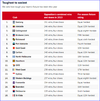- Jan 7, 2010
- 13,001
- 38,184
- AFL Club
- Richmond
- Other Teams
- Adelaide Strikers

A pre-season projection that reigning premiers Geelong had the toughest 2023 home-and-away fixture has been borne out, but Melbourne have emerged as the surprise beneficiary of the vagaries a season brings.
As the season proper heads into a thrilling final fortnight to determine the top eight, we have analysed the full fixture using a simple formula of accumulative wins and draws to rate the depth of competition each team has faced through 22 rounds, and how this translates through the full 24 rounds.
An imbalanced fixture where 18 teams clash over 24 rounds always provokes debate and critical analysis, so the method we have used is but one tool. However, it does highlight the challenge teams have faced.
Using this method, the Cats have played through 22 rounds, and are preparing to play over the next fortnight, teams – so far – with a combined 251 wins and three draws. That they had what was judged to be the toughest fixture heading into the season has been reaffirmed, with pre-season projections based on adding the 2022 ladder positions of the teams a club plays twice. In the Cats’ case, they have Collingwood, Essendon, Fremantle, Port Adelaide, Sydney and Western Bulldogs twice, and sit 11th on the ladder.
Captain Patrick Dangerfield said personnel and in-game consistency had been an issue for the Cats.
“We haven’t executed as well as we would have liked, but we are alive in it. This is the situation we are in, we have got to attack it,” Dangerfield said.
The Demons, a serious premiership threat, were tipped to have had the sixth-hardest fixture, but they and St Kilda have had the friendliest road due, in part, to the AFL’s “weighted rule” to determine who plays each other twice. This system breaks the 18 teams into three groups: the top six teams from the previous year’s ladder (based on finals results), the middle six and bottom six.
While the Demons have met Carlton twice, their double-ups have included North Melbourne, Hawthorn (this weekend) and Richmond.
The pitfalls of a season are varied, for these include injuries and the form of an opponent. In this season’s case, double-ups against North Melbourne and West Coast, with a combined four wins, have been particularly beneficial.
An opponent’s form line can have an impact. The Demons, for instance, beat the Blues during the latter’s six-game losing streak, but on Saturday night were edged out by a red-hot opponent storming into premiership calculations.

St Kilda were tipped to have a relatively friendly fixture, and have technically benefited from having four teams – Gold Coast, Hawthorn, North Melbourne and Richmond – either fully or all but out of finals contention among their double ups. However, in this case, form has not mattered, for they have lost to the Hawks, Suns and Tigers. Despite this, they have been in the top eight all season.
“We don’t think we don’t stack up,” Saints coach Ross Lyon said. “We think we have been a bit inconsistent in games ... we haven’t been out of the eight all year. But, in saying that, we were brave when the season was up for grabs. It gives you leeway when the sea has been a bit rough.″
Adelaide, while also expected over summer to have had a less onerous path, have found themselves with the second-toughest fixture (246 wins and four draws) under the accumulative wins method. This is because, in part, they have met Greater Western Sydney twice, with the Giants having a better season than many expected.
Before Friday night’s clash, Collingwood and the Brisbane Lions have shared the third-toughest fixture, separated from the Tigers by one drawn result. The Magpies, despite losing by a point in a preliminary final last year, had what was rated pre-season the eighth-hardest fixture. But the challenge has been greater because double-ups Adelaide and Essendon have improved immensely, and the Blues have become a force.
The Power, judged pre-season to have the fourth-toughest fixture, haven’t had it easy, for two of their double-ups, the Crows and Essendon, have improved. They have ended up alongside Gold Coast with the equal-sixth-hardest draw.
The Blues (eighth-hardest draw) will deserve their spot in the finals should they end a decade-long absence. Having missed the top eight last season, they had what seemed a relatively friendly fixture, judged the equal 12th-hardest, but a double-up against the surging Magpies and an improved GWS and St Kilda have added to their challenge in a roller-coaster season.
The rebuilding Bombers (16th-hardest draw) were tipped to have one of the easier fixtures, and that’s been spot on, for they have met the Kangaroos and Eagles twice, albeit scrambling over the line against each this month. The Cats’ woes have also technically aided their hopes, but Bombers coach Brad Scott has twice lost to his twin brother.
The Western Bulldogs have been a disappointment, for they were given what seemed the eighth-hardest draw despite making the finals last year, but, under the accumulative method, have had the fourth-easiest run. They have had Fremantle, Richmond and Hawthorn twice, with the loss to the Hawks last weekend in Launceston particularly stinging.
The Swans, grand finalists last year, faced what seemed to be the third-toughest fixture, but the vagaries of the season have led them to have the sixth easiest, in part because double-up Fremantle has slipped. Only one of their double-ups (Melbourne) is a top-four team.
The Giants, also finals hopefuls, have benefited from not having a top-four side among their six double-up games.
Winners and losers: Who really has had the toughest AFL fixture this season?
Forget the pre-season projections. Did your team have the most challenging fixture, or enjoyed an easier ride? We have crunched the numbers for you.




